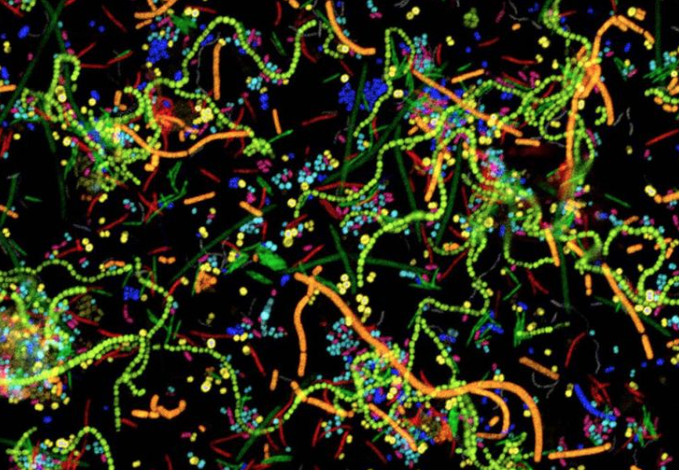There is so much we don’t know about the bacteria we buy and add to our reef tanks. Salem Clemens answers some of your most Frequently Asked Questions on Reef Aquarium Bacteria.
Is it possible to keep bacteria alive in a bottle, i.e., bottled bacteria, for reef aquariums?
Yes, I have seen three common strategies employed in the aquarium trade to keep live bacterial products shelf stable.
- Food sources – some companies will pack their bacteria with food for the long nap they can utilize for an extended period – this food can come in many forms and typically depends on what bacterial strain the product contains
- Dormancy – some companies freeze-dry the bacteria of interest, which reduces the bacterial culture to an easily transported stable powder. This is commonly included in coral foods on the market. Once the bacteria encounter water, they can exit this state of dormancy and become metabolically active again.
- Refrigeration – some companies keep their cultures as “fresh” as possible and rely on a business model involving fast turnaround times. This typically requires retailers to keep the products refrigerated until sold.
Do corals eat bacteria?
Most of the corals’ primary heterotrophic nutrition comes from pico and nanoplankton. This has been eluted recently through several studies. Due to this article’s length, I will only include the results of one of these studies. Without going into a page of technical details (the study is over 100 pages long), this experiment found that Montipora digitata and Porites lutea consume a significant amount of bacteria. The graph below illustrates a positive linear correlation between total nanograms of carbon and nitrogen incorporated into the coral’s tissue as proteins per hour of feeding on pico and nanoplankton at normal and elevated temperatures. A clear trend is shown that when external temperature stress comes into play, nutrition via feeding drops exponentially in both species. Many other studies have been conducted on other species of coral, and similar trends have been found – thus, it is very likely most corals utilize bacteria as a food source.
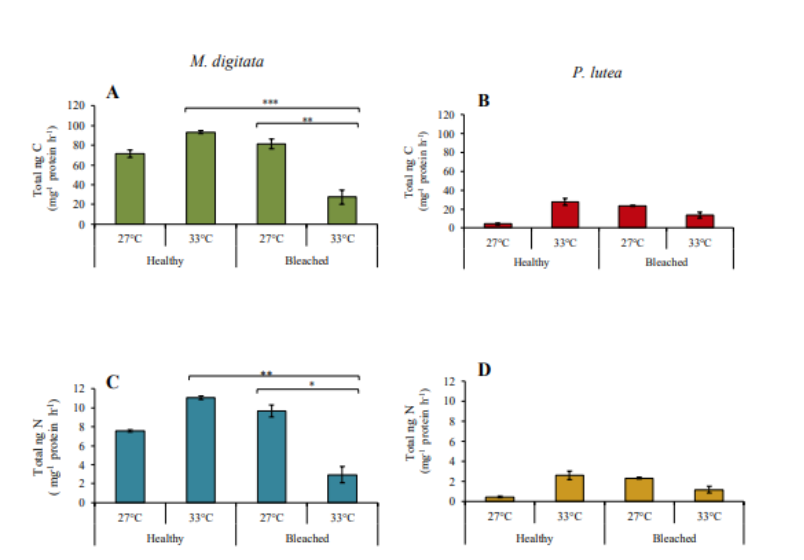
Do corals eat the bacteria used for cycling?
If you directly add a bottle of nitrifying bacteria to a coral as it is in a feeding state, it may uptake some of those cells as food. Writ large though the common ammonia-oxidizing (Nitrosomonadaceae and Nitrosococcus) and nitrite-oxidizing (Nitrobacter, Nitrospinaceae, and Nitrospiraceae) strains that are found in our systems are nonmotile and live on surfaces. Thus, they are not typically found in the water column and are not readily uptaken by coral as food. A typical family that is likely uptaken as food in our systems is Pelagibacteraceae. Additionally, there has been some data to suggest that some species of coral preferentially eat some bacterial families over others (this may be a function of micron size, nutritional needs, potential chemoattractants the coral utilizes to bring in food, local bacterial population density, or a mechanism not currently known) thus because there is still little data on this topic is may be entirely possible that corals do not eat the bacteria commonly associated with the nitrogen cycle.
Is adding many different bacteria a good thing, or does one outcompete the other?
When adding any bacteria to your tank, the first thing to understand is that you want to find the right bacteria for the job. Adding as many bacterial products on the market as possible for diversity’s sake is likely misguided and could result in negative consequences. Different strains will outcompete each other – it’s also likely you may be adding terrestrial bacteria, which could shift your system’s microbial concentrations by uptaking available nutrients that desirable coral-associated microbiota may depend on.
Generally, the best guideline when adding anything to a system is the age-old additive of “don’t lose what you don’t test for.” This solid line of logic typically goes out the window when considering the biological side of our systems. When adding any bacterial product, it’s best to ask yourself a series of questions.
- Why am I adding this product – do I know what effect it will have on my system or the health of the animals in it?
- If I am adding it because others have suggested I do or a company has made broad claims about its use, is there any data to substantiate these claims?
- What strain of bacteria am I adding, and what function should it perform?
The majority of companies on the market are not transparent about what strains are in their products or not clear about what the primary function of their “blend” is. Bacteria are impeccable creatures, often playing diverse and influential roles in an ecosystem. These roles are wholly dependent on their metabolism, lifestyle, etc. – without knowing these crucial details, there’s no way to know what could occur once you add a bacterial product to your system. I think three things should be in order before adding a bacterial product.
- Testing – getting a baseline via Aquabiomics allows you to see your existing microbial community, which can then allow you to evaluate if you need to change the concentration of different families in your system
- Education – after determining what you need, find a product or bacterial source (live rock, live sand, etc.) that can perform your desired function (coral nutrition, pathogen inhibition, bioremediation, etc.)
- Trial – there is little available data regarding the short or long-term effect of dosing many of the bacterial products on the market to our systems – sending in frequent Aquabiomics tests at regular time internals as well as continuing to test your core parameters can allow you to determine if there is any positive or negative effect on your system from a coral health, microbiology or chemistry perspective.
This logic applies to many of the products on the market, but there are apparent exceptions. For instance, if I am starting a tank, adding a bottle of nitrifying bacteria makes sense. The difference in this case is that it is known what strains are in the bottle and what function they will perform (ammonia and nitrite oxidization). With products outside of this realm (except a few), this is not the case, and thus, a layer of skepticism and caution is required.
Is Vibrio a harmful bacteria?
While many bacteria in the family Vibrionaceae are known as primary or opportunistic pathogens, this is not a totalizing view of the group. Some members exist symbiotically with coral and are critical to nutrient cycling and defense against external pathogens in the holobiont. With all things in life – nothing is black and white but instead is often a shade of grey. Thus, I believe it is misguided to attempt to eliminate the presence of this entire family in a system without proper analysis at the species level. Here are four peer-reviewed articles substantiating this claim.
https://www.microbiologyresearch.org/content/journal/ijsem/10.1099/ijs.0.63370-0
https://www.sciencedirect.com/science/article/pii/S0022098109000392
https://www.sciencedirect.com/science/article/pii/S0723202008000453
https://www.int-res.com/abstracts/meps/v322/p1-14
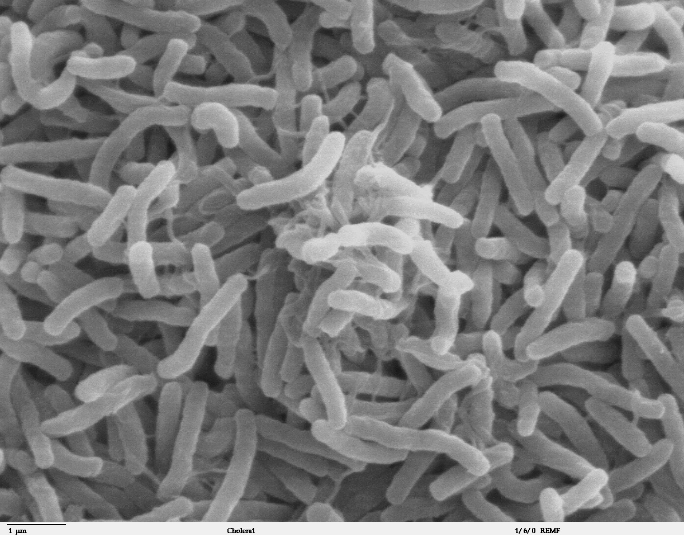
What does carbon dosing do for bacteria?
There are many different types of bacteria – all of which can have various strategies to obtain energy. Some are photosynthetic and can uptake carbon as CO2 from the surrounding atmosphere. Others must “eat” carbon sources in their environment to grow. Carbon dosing in the aquarium targets the bacteria that can metabolize soluble carbon from their environment. Adding in a carbon chain of your choice then allows these bacterial families to grow due to introducing more food into their environment.
What is the best form of carbon dosing?
This is currently unknown, but hopefully, some data will be behind it in the coming months. At this time, Reef Builders and Aquabiomics have initiated a collaborative effort to launch a community science project to answer this question. We are still planning the experiment in-depth behind closed doors but will hopefully begin trials in May and have some data to share by mid-July. We hypothesize that different carbon sources (vinegar, vodka, etc.) will correlate to increased distinct bacterial groups as some bacteria are typically more adept at eating specific carbon sources than others. We want to find what carbon source can promote the growth of beneficial families in the aquarium. Inversely, if we find a carbon source that increases the concentration of undesirable families, this will also be helpful information. You can apply here if you are interested in participating in this experiment. W
https://docs.google.com/forms/d/1Vuy_sW8KVPQsDBnysqZQn6BUr0Bjcphh-Y0qC_3C8o8/edit
Can I kill off cyanobacteria by dosing other forms of bacteria?
This is possible as cyanobacteria can sometimes arise from a system that is too low in diversity (for instance, after dosing antibiotics) due to the unknowns of many bacterial products on the market. A more reliable strategy would be to adjust your nutrient ratios and flow, as cyanobacteria will typically increase in low-flow areas when carbon, nitrogen, and phosphorus values are out of wack.
What does gram negative mean?
Gram-negative and positive are terms derived from a microbial classification technique called “gram staining.” In this process, several counter dyes are applied to a bacterial sample. Depending on the color the bacteria change, you can determine if a bacteria is “gram-negative” or “gram-positive.” Both classifications indicate a difference in the overall structure of the bacteria’s cell walls. This information is critical in determining important information such as antibiotic susceptibility, potential toxin production, etc.
Gram-positive bacteria have one very thick cell wall made of peptidoglycan. Gram-negative bacteria have a very thin primary peptidoglycan wall surrounded by a secondary outer membrane made primarily of lipopolysaccharides (LPS). This acts as extra protection, making them hard to eradicate with some methods.
Many important good and bad bacteria are gram-negative in our aquariums – the bacteria associated with the nitrogen cycle, known coral pathogens such as Vibrio, and known coral food such as Pelagibacteraceae are all gram-negative. Thus, when people utilize antibiotics that target gram-negative bacteria (such as cipro or oxalinic acid) without the proper dose or exposure time, it is likely that many beneficial core microbes are also eradicated.
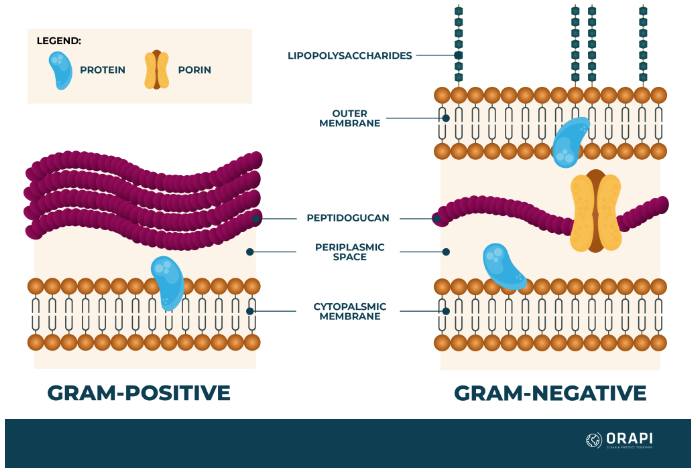
What type of bacteria lowers nitrates?
Many bacterial strains can lower nitrates in a system – the typical “clean” blends likely rely on Bacillus subspecies, which are adept at anaerobic nitrate respiration. The question is – are there any long-term impacts of adding terrestrial bacteria to a closed marine ecosystem? Because we don’t have data to answer this question, I typically opt for other options for removing nitrates – phyto, carbon dosing, or water changes can also achieve a reduction in nitrates (many different methods can as well) – there are plenty of data-driven ways to skin that cat and I find it unwise to pursue the least explored option to solve a problem when many other methods are available that have years of anecdote as well as data behind them.
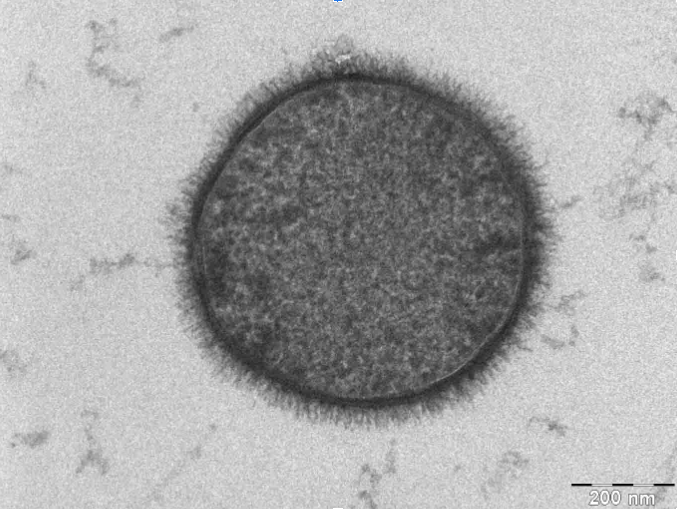
Can you overdose bacteria?
Yes, you can – adding in too much bacteria could strip the system of available oxygen (as well as many other things), which could lead to a system crash – it is essential always to pay attention to manufacturer recommendations for adding a live product.
What microscope do I need to look at bacteria in my home aquarium?
If you are interested in looking at bacteria, a microscope that can see to at least 400x is desirable. At this level of magnification, you will be able to see bacterial cells but cannot make out much besides a general cell shape. A better start would be 1000x, as this would allow some differentiation. Typically, these lenses utilize oil emersion, which can be messy and require some practice (and lots of extra slides and covers). Some relatively affordable options are the AmScope models. Many higher-end options can have higher magnification, field inversion, polarization, etc., but these costs rise relatively fast.
Main image credit: https://www.pinterest.com/pin/party-like-a-microbe–80994493276549083/


